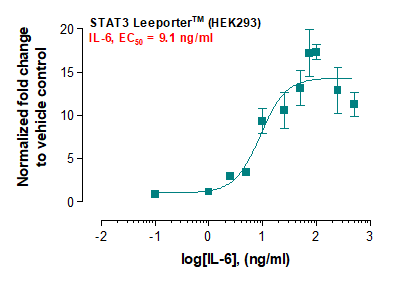Recombinant Human Interleukin-10/IL-10
Shipping Info:
For estimated delivery dates, please contact us at [email protected]
| Amount : | 50 µg |
| Content : | Lyophilized from a 0.2 µm filtered solution of 20mM PB,150mM NaCl,pH7.4. |
| AA sequence : | Recombinant Human Interleukin-10 is produced by our Mammalian expression system and the target gene encoding Ser19-Asn178 is expressed. |
| Alternative Name : | Interleukin-10, IL-10, Cytokine synthesis inhibitory factor, CSIF, IL10, RP11-262N9.1, IL10A, MGC126450, MGC126451, TGIF |
Source : Human Cells;
Interleukin 10(IL10), also known as cytokine synthesis inhibitory factor (CSIF),is a secreted protein and belongs to the IL-10 family. IL-10 is secreted by many activated hematopoietic cell types as well as hepatic stellate cells, keratinocytes, and placental cytotrophoblasts . IL-10 is an anti-inflammatory TH2 cytokine that has a critical role in limiting the immune response to pathogens to prevent host damage. As IL-10 in produced in several T helper populations, it is proposed that it provides a feedback loop to limit the effector functions of macrophages and DCs on T cells. Once expressed, IL-10 signals through the IL-10 receptor (IL-10R) to activate STAT3. As IL-10 is a strong inhibitor of inflammation, it has become a viable biomarker for various diseases and conditions as well as a therapeutic molecule for certain conditions. In addition to elevated levels in parasitic infection, high expression levels of IL-10 are also found in retroviral infections inducing immunodeficiency. The immunosuppressive properties of IL-10 suggest a possible clinical use of IL-10 in suppressing rejections of grafts after organ transplantations
Interleukin 10(IL10), also known as cytokine synthesis inhibitory factor (CSIF),is a secreted protein and belongs to the IL-10 family. IL-10 is secreted by many activated hematopoietic cell types as well as hepatic stellate cells, keratinocytes, and placental cytotrophoblasts . IL-10 is an anti-inflammatory TH2 cytokine that has a critical role in limiting the immune response to pathogens to prevent host damage. As IL-10 in produced in several T helper populations, it is proposed that it provides a feedback loop to limit the effector functions of macrophages and DCs on T cells. Once expressed, IL-10 signals through the IL-10 receptor (IL-10R) to activate STAT3. As IL-10 is a strong inhibitor of inflammation, it has become a viable biomarker for various diseases and conditions as well as a therapeutic molecule for certain conditions. In addition to elevated levels in parasitic infection, high expression levels of IL-10 are also found in retroviral infections inducing immunodeficiency. The immunosuppressive properties of IL-10 suggest a possible clinical use of IL-10 in suppressing rejections of grafts after organ transplantations
|
There are currently no product reviews
|














.png)













